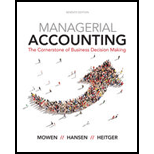
Cost of Capital,
Leakam Company’s product engineering department has developed a new product that has a 3-year life cycle. Production of the product requires development of a new process that requires a current $100,000 capital outlay. The $100,000 will be raised by issuing $60,000 of bonds and by selling new stock for $40,000. The $60,000 in bonds will have net (after-tax) interest payments of $3,000 at the end of each of the 3 years, with the principal being repaid at the end of Year 3. The stock issue carries with it an expectation of a 17.5% return, expressed in the form of dividends at the end of each year (with $7,000 in dividends expected for each of the next 3 years). The sources of capital for this investment represent the same proportion and costs that the company typically has. Finally, the project will produce after-tax
Required:
- 1. Compute the cost of capital for the project. (Hint: The cost of capital is a weighted average of the two sources of capital, where the weights are the proportion of capital from each source.)
- 2. CONCEPTUAL CONNECTION Compute the NPV for the project. Explain why it is not necessary to subtract the interest payments and the dividend payments and appreciation from the inflow of $50,000 in carrying out this computation.
Trending nowThis is a popular solution!

Chapter 12 Solutions
Cengagenowv2, 1 Term Printed Access Card For Mowen/hansen/heitger?s Managerial Accounting: The Cornerstone Of Business Decision-making, 7th
- Suppose the following two independent investment opportunities are available to Fitz, Inc. The appropriate discount rate is 12%. Year Project Gamma Project Theta 0 -$2,500 -$4,100 1 1,300 800 2 1,100 2,100 3 900 3,600 Calculate the profitability index (PI) for each project. Which project should the company accept based on the PI rule? Consider the following cash flows on two mutually exclusive projects for a company. Both projects require an annual return of 15%. Year Project A Project B 0 -$725,500 -$1,450,900 1 275,000 889,000 2 413,800 647,330 3 382,075 554,280 As a financial analyst for the company, you are asked the following questions: If your decision rule is to accept the project with the higher IRR, which project should you choose? Because you are fully aware of the scale problem associated with IRR rule, you calculate the incremental IRR for the cash flows. Based on your…arrow_forwardNeed helparrow_forwardAnswerarrow_forward
- Need help with this financial accounting questionarrow_forwardPurple Corp. reported under GAAP for the year ended 12/31/2024 depreciation expense $45,000 and warranty expense $25,000. During 2024, $5,000 in warranties were serviced, and the remainder is estimated to be serviced over the following 4 years. Under the tax code, depreciation for 2024 would be $60,000. Assuming these are the only differences between GAAP and the tax code, how much would be reported as a deferred tax expense or deferred tax benefit on the income statement for the year ended 12/31/2024 if the future tax rate will be 30%? A A deferred tax expense of $4,500 B A deferred tax benefit of $6,000 C A deferred tax expense of $1,500 D A deferred tax benefit of $1,500arrow_forwardWanna answerarrow_forward
 Managerial Accounting: The Cornerstone of Busines...AccountingISBN:9781337115773Author:Maryanne M. Mowen, Don R. Hansen, Dan L. HeitgerPublisher:Cengage Learning
Managerial Accounting: The Cornerstone of Busines...AccountingISBN:9781337115773Author:Maryanne M. Mowen, Don R. Hansen, Dan L. HeitgerPublisher:Cengage Learning EBK CONTEMPORARY FINANCIAL MANAGEMENTFinanceISBN:9781337514835Author:MOYERPublisher:CENGAGE LEARNING - CONSIGNMENT
EBK CONTEMPORARY FINANCIAL MANAGEMENTFinanceISBN:9781337514835Author:MOYERPublisher:CENGAGE LEARNING - CONSIGNMENT Cornerstones of Cost Management (Cornerstones Ser...AccountingISBN:9781305970663Author:Don R. Hansen, Maryanne M. MowenPublisher:Cengage Learning
Cornerstones of Cost Management (Cornerstones Ser...AccountingISBN:9781305970663Author:Don R. Hansen, Maryanne M. MowenPublisher:Cengage Learning Managerial AccountingAccountingISBN:9781337912020Author:Carl Warren, Ph.d. Cma William B. TaylerPublisher:South-Western College PubPrinciples of Accounting Volume 2AccountingISBN:9781947172609Author:OpenStaxPublisher:OpenStax College
Managerial AccountingAccountingISBN:9781337912020Author:Carl Warren, Ph.d. Cma William B. TaylerPublisher:South-Western College PubPrinciples of Accounting Volume 2AccountingISBN:9781947172609Author:OpenStaxPublisher:OpenStax College





